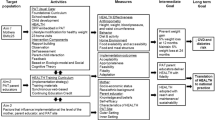Abstract
The association of risk factors such as smoking, nutrition and adolescence with low birthweight has been well documented. What is less known is the extent to which certain program interventions can mediate the impact of these risks on low birthweight and the level of intervention necessary to have an impact. This study had two objectives: (a) to explore the role of the Toronto Healthiest Babies Possible (HBP) program as a mediator of the impact of smoking, adolescence, prepregnancy underweight and erratic weight gain/initial weight loss on LBW, and (b) to determine the dose-response relationship between the number of home visits and LBW. Study results suggest that the HBP strategy is making a difference for clients with the aforementioned three risk factors, and that the most effective intervention “dose” to reduce low birthweight is 9–11 visits. This type of study may serve as a benchmark in the evaluation of other similar programs.
Résumé
L’association qui existe entre d’une part des facteurs de risque tels que le tabagisme, la nutrition et l’adolescence, et d’autre part le faible poids à la naissance est bien connue. Ce que l’on connaît moins c’est la mesure dans laquelle certaines interventions peuvent atténuer l’impact de ces risques sur le faible poids à la naissance et le niveau d’intervention nécessaire pour ce faire. Cette étude avait deux objectifs: (a) étudier le rôle du programme HBP (Healthiest Babies Possible) de Toronto en tant qu’élément pour atténuer l’impact du tabagisme, de l’adolescence, de l’insuffisance pondérale et de la prise de poids erratique/perte de poids initiale avant la grossesse sur les naissances de faible poids, et (b) déterminer la relation dose-réponse entre le nombre de visites à domicile et le faible poids à la naissance. Les résultats de l’étude semblent indiquer que la stratégie suivie par le programme HBP change les choses pour les clients concernés par les trois facteurs de risque susmentionnés, et que la „ dose ” d’intervention la plus efficace pour réduire le faible poids à la naissance est de l’ordre de 9 à 11 visites. Ce type d’étude pourra servir de référence à l’évaluation d’autres programmes analogues.
Similar content being viewed by others
References
Lang JM, Lieberman E, Cohen A. A comparison of risk factors for preterm labor and term small-for-gestational-age birth. Epidemiology 1996;7:369–76.
Cogswell ME, Yip R. The influence of fetal and maternal factors on the distribution of birth-weight. Semin Perinatol 1995;19(3):222–40.
Rutter DR, Quine L. Inequalities in pregnancy outcome: A review of psycho-social and behavioural mediators. Soc Sci Med 1990;30(5):553–68.
Turner RJ, Grindstaff CF, Phillips N. Social support and outcome in teenage pregnancy. J Health Soc Behav 1990; 31:43–57.
Wilcox MA, Smith SJ, Johnson IR, et al. The effect of social deprivation on birthweight, excluding physiological and pathological effect. Br J Obstet Gynaecol 1995;102:918–24.
Abrams B, Selvin S. Maternal weight gain pattern and birth weight. Obstet Gynecol 1995;86:163–69.
Moutquin JM, Milot-Roy V, Irion O. Preterm birth prevention: Effectiveness of current strategies. J SOGC 1996;18:571–88.
Doyle W, Crawford MA, Wynn AHA, Wynn SW. Maternal nutrient intake and birthweight. J Hum Nutr Diet 1989;2:415–22.
Dubois S, Coulombe C, Pencharz P, et al. Ability of the Higgins Nutrition Intervention Program to improve adolescent pregnancy outcome. J Am Diet Assoc 1997;97:871–78.
Muscati SK, Gray-Donald K, Newson EE. Interaction of smoking and maternal weight status in influencing infant size. Can J Public Health 1994;85(6):407–12.
Shu XO, Hatch MC, Mills J, et al. Maternal smoking, alcohol drinking, caffeine consumption and fetal growth: Results from a prospective study. Epidemiology 1995;6:115–20.
Desrosiers Choquette J, Julien M. Canada Prenatal Nutrition Program, Part II: Review of Key Canadian Programs. Health Canada, January 1998, unpublished.
Higgins AC, Moxley JE, Pencharz PB, et al. Impact of the Higgins Nutrition Program on birth weight: A within-mother analysis. J Am Diet Assoc 1989;89:1097–103.
Buescher PA, Larson LC, Nelson MD, Lenihan AJ. Prenatal WIC participation can reduce low birthweight and newborn medical costs: A cost-benefit analysis of WIC participation in North Carolina. J Am Diet Assoc 1993;93:163–66.
Mendelson R, Dollard D, Hall P, et al. The impact of the Healthiest Babies Possible program on maternal diet and pregnancy outcome in underweight and overweight clients. J Can Diet Assoc 1991;52(4):229–34.
Poland ML, Giblin, PT, Walker JB, Hankin J. Effects of a home visiting program on prenatal care and birthweight: A case comparison study. J Community Health 1992;17:221–29.
Blondel B, Breart G. Home visits during pregnancy: Consequences on pregnancy outcome, use of health services, and women’s situations. Semin Perinatol 1995;19:263–71.
Bradley PJ, Martin J. Issues inherent in measuring the impact of care coordination on pregnancy outcomes. Public Health Nurs 1996;13:276–83.
Kitzman H, Olds DL, Henderson CR, et al. Effect of prenatal and infancy home visitation by nurses on pregnancy outcomes, childhood injuries, and repeated childbearing. JAMA 1997;278:644–52.
Desjardins E. Healthiest Babies Possible: June 1994–June 1996 Program Evaluation. Toronto Community Services Public Health, June 1997, unpublished.
MacMahon B, Pugh TF. Epidemiology Principles and Methods. Boston: Little, Brown and Company, 1970;235–37.
Blair C, Ramey CT, Hardin JM. Early intervention for low birthweight, premature infants: Participation and intellectual development. Am J Ment Retard 1995;99(5):542–53.
Kramer M. Determinants of low birthweight: Methodological assessment and meta-analysis. Bull WHO 1987;65:663–737.
Author information
Authors and Affiliations
Corresponding authors
Rights and permissions
About this article
Cite this article
Desjardins, E., Hardwick, D. How Many Visits by Health Professionals are Needed to Make a Difference in Low Birthweight? A Dose-response Study of the Toronto Healthiest Babies Possible Program. Can J Public Health 90, 224–228 (1999). https://doi.org/10.1007/BF03404120
Received:
Accepted:
Published:
Issue Date:
DOI: https://doi.org/10.1007/BF03404120




